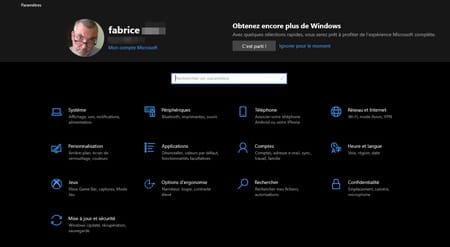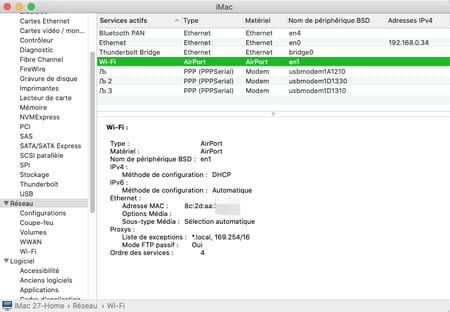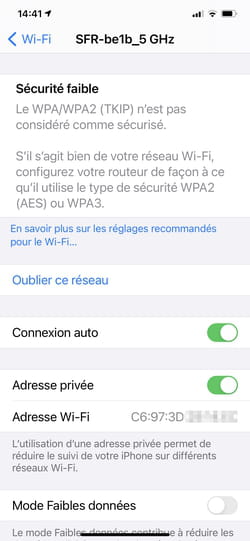Any device that can connect to a network or the Internet (PC, smartphone, tablet, TV, watch, speaker, surveillance camera, etc.) has a unique identifier in the world: its MAC address. Here’s how to find out.
Contrary to what its name might suggest at first glance, the MAC address has absolutely no relation to the famous Apple computers, MAC being the acronym for Media Access Control. Composed of twelve hexadecimal characters, this address qualified as “physical” is used to uniquely identify any electronic object having a network interface, wired or wireless, whatever its nature. Thus, all devices that can connect to a network (computer, phone, tablet, game console, Internet box, printer, TV, Wi-Fi repeater, speaker, connected bulb, IP surveillance camera, connected watch, etc.) have at least one specific MAC address – more precisely, they have as many as there are network components.
Obviously, there is no point in knowing by heart the MAC address of a computer or a telephone, because we do not need it on a daily basis! On the other hand, it is good to know how to find it when necessary, for example, when you want to filter access to an Internet box or a Wi-Fi network, whether to set up parental controls or to prevent unauthorized – or even completely unknown – devices to connect surreptitiously. A very simple operation, whatever the environment.
What is a MAC address?
Even if they are both linked to the network and to the Internet, we must not confuse MAC address and IP address (see our practical sheets Find your public IP address and Find the local IP address of a computer or mobile). Indeed, a MAC address is specific to a device – such as a social security number for an individual, or a registration number for a vehicle -, while an IP address corresponds to a connection that can change depending on the context or geographic location – just like a mailing address.
In practice, it is the manufacturer not of the finished product but of the network component who determines the MAC address of a device during the manufacture of said electronic circuit. This is why it is often said that the MAC address is “hardware” or “physical”, because it is “hard” written in a device.
A MAC address is always presented as six groups of two hexadecimal characters, usually separated by colons or dashes: for example, a2: bb: 36: 5b: 9c: 34 or 74-2F-68-E9 -A1-53, depending on whether the letters are written in lowercase or uppercase, which doesn’t matter. The first three groups correspond to the manufacturer and type of the network component – they are thus common to a range of circuits – while the last three serve as a unique number to identify the component – they can sometimes be modified later by the user.
There are two very easy ways to find the MAC address of a Windows PC: with a command line or through Windows settings. Be careful, however, a computer can have two MAC addresses: one for the Ethernet network component, another for the Wi-Fi component.
- If you are a fan of keyboard commands, press the keys Win + R, then in the window Run displayed, type cmd and validate with the key Entrance in order to launch the Windows Command Prompt.
- In the window that appears, enter the command getmac / v and confirm by pressing the key Entrance of the keyboard.

- The names of the network components found on the PC and the corresponding MAC addresses are immediately displayed.

- If you prefer graphical interfaces, click on the button To start up then on Settings, or type the keyboard shortcut Windows + I to access Windows settings.

- Then click on Network and Internet. In the window that appears, activate the button Properties under the type of network interface currently in use (Wi-Fi or Ethernet).

- Scroll down the page. The MAC address of the network component is displayed under the heading Physical address (MAC).

- To find out the MAC address of the second network component (Ethernet for example), go back and click on Ethernet in the left pane. Then click on Ethernet in the central pane.

- At the bottom of the page, appears the MAC address of this component under the heading Physical address (MAC).

To get all the information you need about the MAC address from macOS, you have two options: the shortest way is to use the system report. But you can also go through the System Preferences panel.
- Click on the menu Apple at the top left of Finder and choose About this Mac.

- In the window that appears, click System report.

- A new window appears on the screen. All the characteristics of your machine are detailed there. Click on Network in the left pane.

- In the upper part of the window, activate Ethernet. Scroll down the lower part. The MAC address of your network card is listed there.
- To find out the MAC address of your Wi-Fi card, click in the upper part of the window on Wifi Airport. You can view the MAC address in the lower area of the window.

- If you prefer to go through the System Preferences panel, activate it then click on Network.

- In the window that appears, select the type of connection currently used (Ethernet, for example) and click on the button Advanced at the bottom right.

- Now click on the tab Equipment. The MAC address of the Ethernet module is displayed.

- To find out the MAC address of the Wi-Fi module, repeat the operation by selecting Wireless in the left pane, and then click the button Advanced.

- The Mac address of the Wi-Fi component is indicated at the bottom of the window of the first tab Wireless. You will also find it in the tab Equipment.

On some Android smartphones, the MAC address can be renewed randomly in order to avoid being able to track your phone using it. However, you can get to know it without difficulty. Note: the titles of the menus and their location may vary depending on the version of Android installed on your device and the manufacturer’s software overlay.
- Go to the settings on your phone or tablet. Press on Connections Where Networks and Internet.

- Tap the name of the Wi-Fi network to which the mobile is connected, at the top of the screen.

- Press again the network name or on the wheel notched.

- Immediately, your connection information is displayed. Scroll down the page if necessary. If your MAC address is not there, press Settings advances. This time your MAC address is displayed.

On iOS, getting your MAC address is easy. The information is tucked away in the device’s network settings.
- Access to Settings on your iPhone or iPad, and then tap Wireless (where the name of the Wi-Fi network to which you are currently connected must also appear).

- Push the button i blue at the end of the line.

- The device’s MAC address appears at the bottom of the screen under the name of Wi-Fi Address.

How to find the MAC address of a connected object?
While it is very easy to find the MAC address of a computer, phone or tablet, it can be more difficult to find that of another connected device. On a device with even a minimalist screen, such as a television, e-reader or home cinema amplifier, it is usually sufficient to explore the menus to find the MAC address in the network settings – the path varies between models and models. devices. On the other hand, it is impossible to proceed in this way on objects without screens such as connected lamps or certain Wi-Fi repeaters. Sometimes, the MAC address is written on a label stuck on the packaging or on the back of the device. device, but it is not systematic.

The solution then consists of retrieving this information directly from the Internet box, router or wireless access point, via its management interface (see our practical sheet 192.168.0.1 192.168.1.1 192.168.0.254: how to access an Internet box). Of course, the operations to be carried out again vary from one model to another, but by browsing the network and Wi-Fi settings, we usually find the MAC address of the connected devices – and sometimes even of those that are connected. are connected at least once to the network, even if they are no longer active at the time of the examination! Here are two examples of operations, with a SFR box and a Freebox. You can adapt them to other boxes and routers (Orange, Bouygues Telecom, etc.), including by using mobile applications.
With a SFR box
- To find the MAC addresses of devices currently connected to an SFR box, connect to the box’s management interface. Then click on the tab Network on the top corner left.
- In the page that appears, activate the link My local network in the left pane.
- The new page that appears presents a diagram of your local network with devices connected to Wi-Fi networks (top) and those connected to Ethernet (bottom).
- The box can be a little capricious and only present the local IP address of the connected device as well as its MAC address … but not its name. It is therefore difficult to identify it. Be aware, however, that devices that only have a MAC address and nothing else are not connected at this precise moment.
- To find out which device is currently connected but not identified, it will be necessary to proceed by elimination. Either you already know its MAC address thanks to the operations carried out above (in this case, it is enough to compare it with those displayed by the box), or you will have to disconnect your devices one by one to locate the dungeon. If its MAC address is still displayed but its local IP address disappears, bingo!
With a Freebox
- On a computer on your local network, connect to the management interface of your Freebox, then double-click on Network Peripherals.

- The window that opens displays all the devices that have connected at least once to your local network, with their name. Normal icons indicate the devices currently connected while the gray ones correspond to absent devices.

- Double click on an icon, even grayed out. A new window opens displaying the MAC address of the corresponding device in plain text, even if it is absent!






